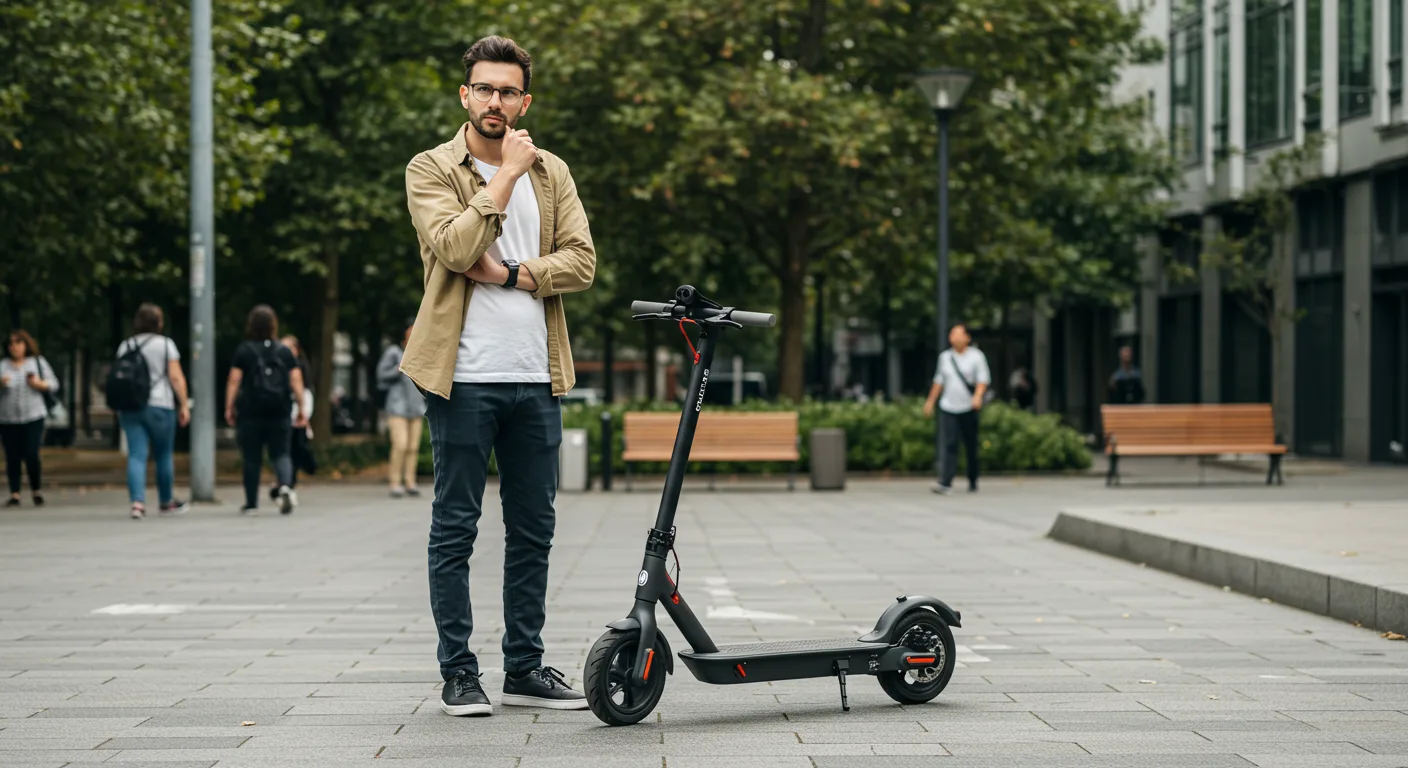1- Battery Life & Range: How Far Can Your Electric Scooter Go?
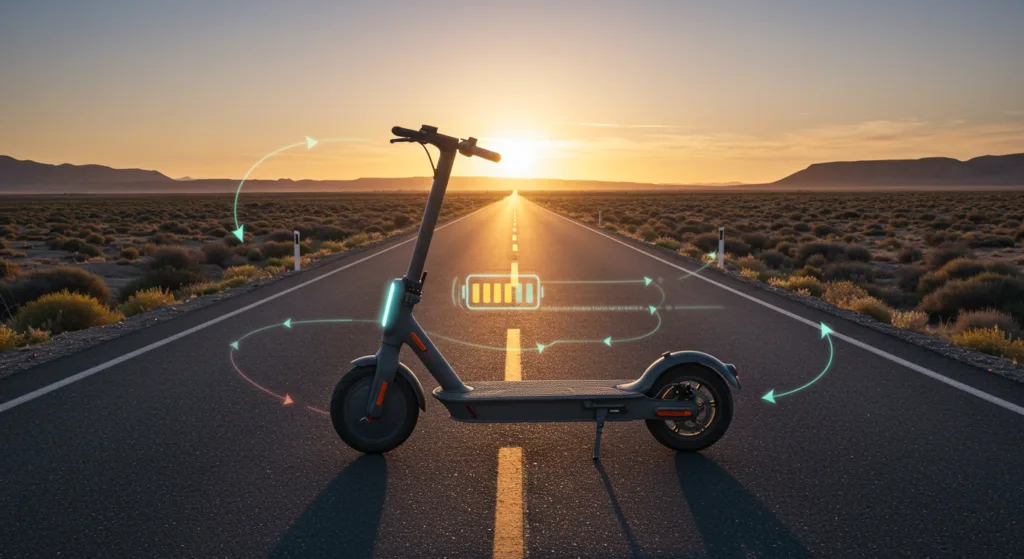
One of the most critical factors to consider before buying an electric scooter is battery life and range. If your scooter runs out of power in the middle of your commute, it can be a frustrating experience. Understanding how long your scooter can last on a single charge is essential for making an informed decision.
1- What Affects Battery Life & Range?
Several factors influence the actual range of an e-scooter:
- Battery Capacity (Ah & Wh): Higher watt-hours (Wh) means longer range. For example, a 500Wh battery can typically cover 25–35 km, while a 1000Wh battery can reach 50–70 km.
- Motor Power: A more powerful motor (e.g., 500W vs. 250W) drains the battery faster.
- Rider Weight: A heavier rider reduces efficiency, cutting down range.
- Terrain & Incline: Hills and rough surfaces require more power, reducing range significantly.
- Speed & Riding Mode: Riding at max speed consumes battery faster. Eco modes extend range.
- Weather Conditions: Cold temperatures can reduce battery performance by 10–20%.
2- Battery Types & Charging Time
Most e-scooters use lithium-ion batteries, which are lighter, durable, and have longer lifespans than lead-acid batteries. Charging times vary:
- Standard Chargers: 4–6 hours for a full charge
- Fast Chargers: Can reduce charge time by 30–50%
- Battery Lifespan: Typically lasts 500–1000 charge cycles, meaning 2–4 years of regular use
3- How to Maximize Your Scooter’s Range?
- Charge your scooter properly: Avoid letting the battery drop below 20% before recharging.
- Maintain tire pressure: Low pressure increases friction, reducing efficiency.
- Avoid aggressive acceleration: Smooth riding improves energy efficiency.
- Store in moderate temperatures: Extreme heat or cold affects battery performance.
If you need long-range performance, look for models like the Segway Ninebot MAX (65 km range) or the EMOVE Cruiser (80 km range), which are designed for extended travel.
2- Motor Power & Speed: Choosing the Right Performance Level

The motor power of an electric scooter determines how fast it can go and how well it handles different terrains. Choosing the right wattage is crucial based on your riding needs.
1- Understanding Motor Power (Watts)
Electric scooter motors typically range from 250W to 5000W. Here’s what you need to know:
- 250W – 350W: Good for flat roads, city commuting, and speeds of 20–25 km/h.
- 500W – 800W: Ideal for hilly areas and faster rides, reaching 30–40 km/h.
- 1000W – 2000W: High-performance scooters for off-roading and steep inclines. Speeds can exceed 50 km/h.
- 3000W+: Extreme power, mainly for racing or high-speed commuting, hitting 60–80 km/h.
2- Speed Limits & Legal Restrictions
Most cities have speed regulations for e-scooters. For example:
- Europe (Germany, France, Spain): Max speed 25 km/h
- USA (California, New York): Typically limited to 24–32 km/h
- UK: Road use restricted unless approved for rental programs
Before purchasing a high-speed scooter, ensure you understand the local laws to avoid fines or restrictions.
3- Single Motor vs. Dual Motor: Which One to Choose?
- Single Motor (250W – 800W) → Lighter, cheaper, better for daily commuting.
- Dual Motor (1000W – 5000W) → More power, better hill climbing, faster acceleration, but heavier and more expensive.
4-Best E-Scooters by Power & Speed
- Best for Commuting: Xiaomi Mi Electric Scooter 4 Pro (350W, 25 km/h)
- Best for Speed: Kaabo Wolf Warrior 11 (5400W, 80 km/h)
- Best for Hills: Dualtron Thunder (5400W, 70 km/h)
Choose a motor based on your daily routes, terrain, and speed preferences to get the most efficient and legal performance.
3- Weight Limit & Load Capacity: Ensuring a Safe Ride
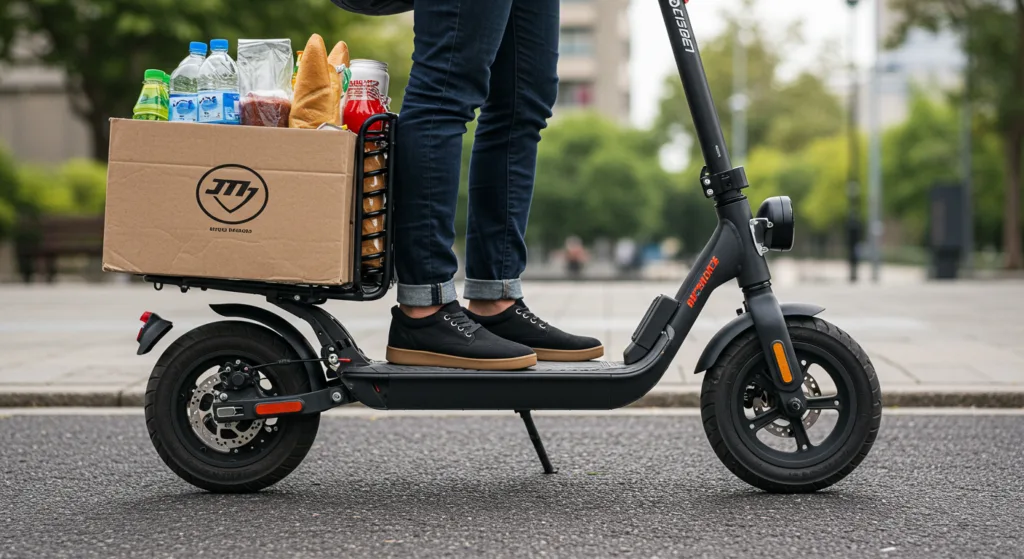
Every electric scooter comes with a weight limit, and exceeding it can affect performance, battery life, and safety. If you’re on the heavier side, or planning to carry extra weight (like a backpack), choosing the right scooter capacity is essential.
1- Why Weight Limit Matters?
- Affects Performance: Heavier loads reduce speed and acceleration.
- Impacts Battery Life: Overloading drains battery faster, cutting range.
- Reduces Durability: The frame, suspension, and tires wear out quicker.
- Safety Risks: Braking distance increases, and handling becomes unstable.
2- Typical Weight Limits by Scooter Type
- Lightweight Scooters (250W – 350W): Support 100–120 kg
- Mid-Range Scooters (500W – 1000W): Handle 120–150 kg
- Heavy-Duty & Off-Road Scooters (2000W+): Designed for 150–200 kg riders
3- Best Scooters for Heavier Riders
If you need a scooter with a higher weight capacity, consider these models:
- EMOVE Cruiser: Supports 160 kg, with a 1000W motor
- Kaabo Wolf King GT: Handles 180 kg, with dual 2000W motors
- Dualtron X2: Built for 200 kg, with extreme power and durability
4- How to Maintain Performance if You’re Near the Weight Limit?
- Choose larger wheels (10-inch+): Better shock absorption.
- Get a powerful motor (500W+): Prevents slowdowns on inclines.
- Check suspension quality: Dual suspension ensures comfort on rough roads.
- Opt for a larger battery: More capacity helps maintain range.
4- Tires & Suspension: Smooth Ride or Bumpy Experience?
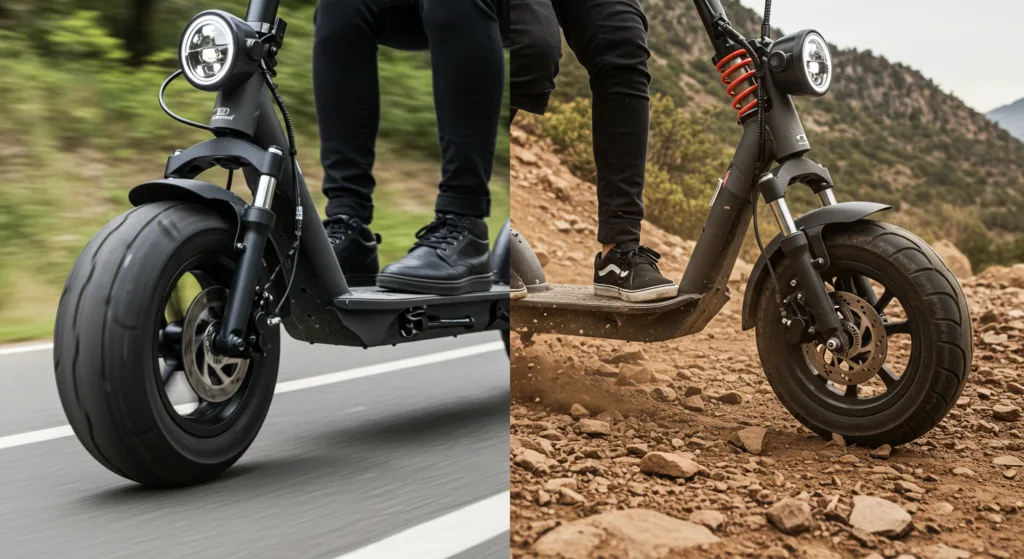
When choosing an electric scooter, ride comfort is a crucial factor, especially if you’ll be commuting on uneven roads or long distances. The tires and suspension system determine how smooth or bumpy your ride will be.
1- Types of E-Scooter Tires
There are two main types of tires in electric scooters:
- Solid (Airless) Tires
- Pros: Puncture-proof, low maintenance, durable
- Cons: Less shock absorption, rougher ride on bumpy surfaces
- Best for: Short-distance commuting, smooth city roads
- Pneumatic (Air-Filled) Tires
- Pros: Better grip, shock absorption, smoother ride
- Cons: Prone to flats, requires regular air pressure checks
- Best for: Long commutes, rough or uneven roads
2- Suspension System: Do You Need One?
If you frequently ride on rough roads, a good suspension system is essential. There are three main types:
- Spring Suspension: Common in mid-range scooters, absorbs minor shocks.
- Hydraulic Suspension: Found in high-end models, provides maximum comfort.
- Rubber Suspension: A low-maintenance alternative but less effective on bumpy roads.
3- Best Scooters for Smooth Riding
- Xiaomi Mi Scooter Pro 2 – Pneumatic tires, no suspension (best for smooth roads).
- Segway Ninebot Max – Pneumatic tires + spring suspension (great for city rides).
- Kaabo Wolf Warrior 11 – Large pneumatic tires + hydraulic suspension (ideal for off-road).
If you’re riding on smooth pavements, airless tires may be fine, but for bumpy roads or long-distance travel, always opt for pneumatic tires with suspension.
5- Braking System: Disc, Drum, or Regenerative Brakes?
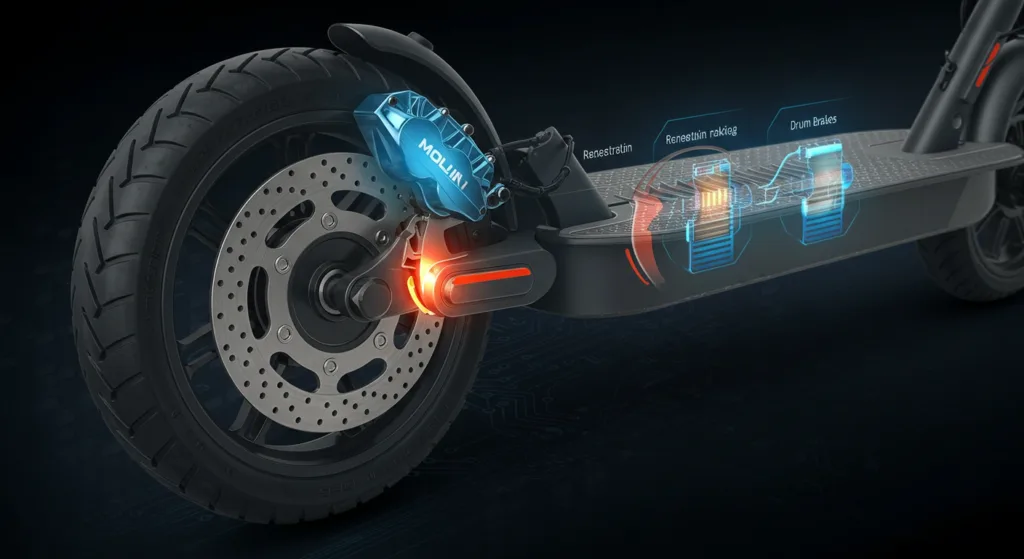
Brakes are one of the most important safety features in an electric scooter. Whether you’re riding at 25 km/h or 50 km/h, a good braking system can be the difference between stopping safely or crashing.
1- Types of E-Scooter Brakes
- Disc Brakes (Best Performance)
- Pros: Strong braking power, works well in all conditions, quick response
- Cons: Requires occasional maintenance
- Found in: Premium scooters like Dualtron Thunder, Kaabo Mantis
- Drum Brakes (Low Maintenance)
- Pros: Enclosed system, works well in rain, requires little maintenance
- Cons: Less stopping power than disc brakes
- Found in: Budget to mid-range scooters like Segway Ninebot Max
- Regenerative Brakes (Energy-Efficient)
- Pros: Uses motor resistance to slow down, extends battery life
- Cons: Less effective for emergency braking
- Found in: Most electric scooters as a secondary braking system
- Foot Brakes (Basic & Least Effective)
- Pros: Simple, no maintenance
- Cons: Less stopping power, not ideal for high speeds
- Found in: Entry-level scooters like Xiaomi M365
2- Which Brake Type is Best for You?
- For daily commuting: Disc or drum brakes
- For high speeds & hills: Dual-disc brakes or hydraulic brakes
- For budget scooters: Drum + regenerative braking
💡 Pro Tip: A scooter with dual braking (e.g., disc + regenerative) provides the best safety and stopping power.
6- Portability & Foldability: Is It Easy to Carry and Store?

If you plan to carry your electric scooter up stairs, onto public transport, or store it in a small space, portability is key.
1- What Makes an E-Scooter Portable?
- Weight: Lighter models (10–15 kg) are easier to carry.
- Folding Mechanism: Quick-folding scooters save time and space.
- Handlebar & Stem Size: Some models fold completely, making them more compact.
2- Weight Guide for Different Scooter Types
- Ultra-Light (Under 12 kg): Xiaomi Mi Essential – Ideal for short commutes.
- Mid-Weight (12–18 kg): Segway Ninebot Max – Balance of portability and range.
- Heavy (18–30 kg): Dualtron Eagle Pro – Powerful but harder to carry.
- Extreme (30 kg+): Kaabo Wolf Warrior – NOT portable, best for long-distance rides.
3- Best Foldable Scooters for Portability
- Xiaomi Mi 4 Pro – Lightweight & ultra-portable.
- TurboAnt X7 Pro – Detachable battery for easy carrying.
- Apollo City 2023 – Folds in 3 seconds, great for urban use.
🚆 If you need to carry your scooter daily, choose a model under 15 kg with a simple folding mechanism.
7- Build Quality & Durability: Frame Materials That Last
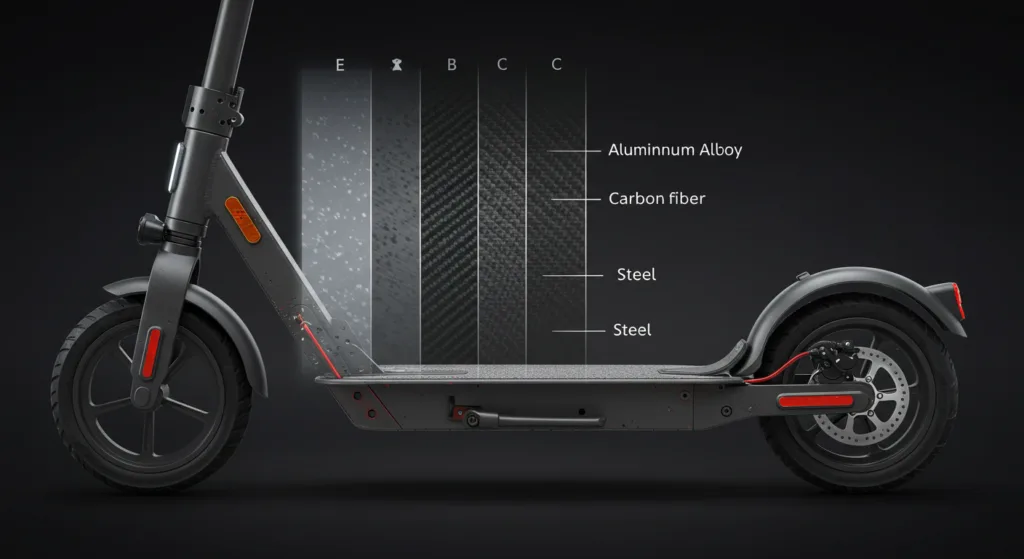
The build quality of an electric scooter determines its longevity, ride comfort, and safety. A well-built scooter withstands daily use, rough terrain, and different weather conditions without deteriorating quickly.
1- Key Factors That Affect Build Quality
- Frame Material
- Aluminum Alloy: Most common, lightweight, and corrosion-resistant. Found in Xiaomi, Segway Ninebot scooters.
- Steel: Stronger but heavier, used in high-performance scooters like Dualtron Thunder.
- Carbon Fiber: Ultra-light yet expensive, used in premium foldable scooters.
- Water Resistance (IP Rating)
- IP54: Can handle light rain but not submersion.
- IPX6 or higher: Fully water-resistant, great for all-weather riding.
- Example: Segway Ninebot Max has IPX5 (good for light rain).
- Weight Capacity
- Scooters with reinforced frames can support 120–150 kg or more.
- Kaabo Wolf King GT: Built for heavy riders (supports 180 kg).
- Folding Mechanism Durability
- Weak folding joints lead to wobbling and frame instability.
- Look for secure locking systems (e.g., Apollo Phantom has a reinforced folding stem).
2- Scooters with the Best Build Quality
- For Everyday Use: Segway Ninebot Max (Aluminum, IPX5)
- For Heavy Riders: Kaabo Wolf Warrior 11 (Steel frame, 180 kg capacity)
- For Premium Durability: Dualtron Thunder 2 (Aircraft-grade materials)
💡 Pro Tip: Always check customer reviews for long-term durability before buying.
8- Safety Features: Lights, Reflectors, and Helmets Matter
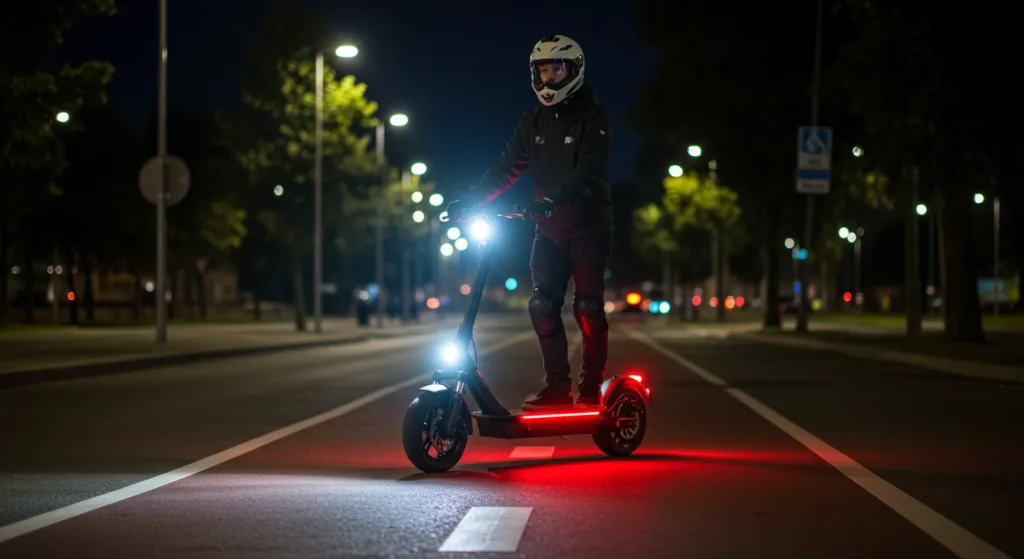
E-scooters are compact and often difficult for drivers to see, making proper safety features essential to avoid accidents.
1- Must-Have Safety Features
- Headlights & Taillights
- Bright LED headlights (300–800 lumens) improve night visibility.
- Integrated taillights make you visible to vehicles.
- Example: Apollo City 2023 has ultra-bright dual LED lights.
- Brake Lights & Turn Signals
- Flashing brake lights alert cars behind you.
- Turn signals help in traffic (available in EMOVE Cruiser, Kaabo Mantis 10).
- Reflectors & Side Lights
- Required by law in many countries for visibility at night.
- Segway Ninebot F25E comes with built-in reflectors.
- Helmet & Protective Gear
- Mandatory in many cities if riding over 25 km/h.
- Full-face helmets recommended for high-speed scooters like Dualtron Storm.
- Smart Safety Features
- Automatic brake lights & horn alerts (found in premium scooters).
- App-controlled security lock (e.g., Xiaomi Mi Pro 2).
2- Best E-Scooters for Safety
- Best for Visibility: Apollo City Pro (Super-bright LED lights, turn signals).
- Best for High-Speed Safety: Dualtron Thunder (Hydraulic brakes, strong lighting).
- Best for Beginners: Segway Ninebot Air T15 (Automatic lights, compact).
💡 Tip: If you ride at night, install additional helmet lights for maximum safety.
9- Legal Regulations: Where Can You Ride Your E-Scooter?
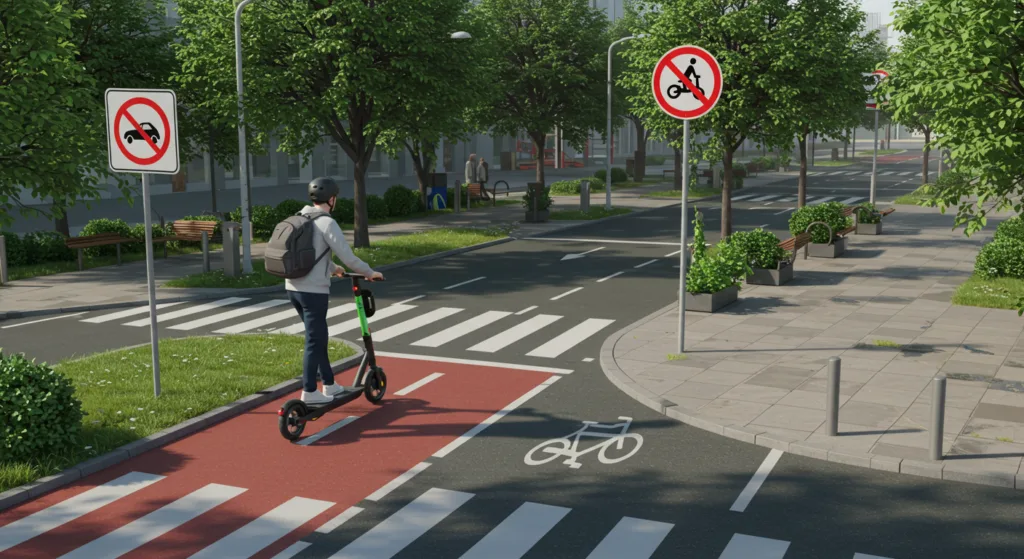
E-scooter laws vary by country and city, and not knowing the rules can lead to fines or confiscation.
1- Common E-Scooter Laws Around the World
| Country | Max Speed | Road Rules | Helmet Requirement |
|---|---|---|---|
| 🇪🇺 EU (Germany, France, Spain) | 25 km/h | Bike lanes only | Optional under 25 km/h |
| 🇬🇧 UK | 25 km/h | Only legal in rental schemes | Mandatory for rental scooters |
| 🇺🇸 USA (California, New York) | 24–32 km/h | Allowed in bike lanes | Required under 18 |
| 🇦🇺 Australia | 25 km/h | Some states require road registration | Mandatory |
| 🇨🇦 Canada (Ontario, BC) | 24 km/h | Bike paths only | Recommended |
2- Where Can You Ride?
- Allowed on bike lanes: Most of Europe and US states like California.
- Not allowed on sidewalks: Illegal in France, Germany, and most US states.
- Full road use restrictions: UK (except rental programs).
3- What Happens If You Break the Law?
- Fines range from €135 (France) to £300 (UK).
- In some places, police confiscate illegal scooters (e.g., UK).
💡 Pro Tip: Always check local e-scooter laws before purchasing, especially speed limits and road permissions.
10- Price vs. Features: Finding the Best Value for Your Budget

Not all e-scooters are created equal. Some offer premium features at a low price, while others overcharge for basic specs.
1- How to Choose the Best Value for Money?
- Define Your Needs First
- Daily Commuting (Short Distance)? → Look for lightweight, foldable scooters like Xiaomi Mi 3.
- Long-Distance & High Performance? → Choose models with larger batteries like EMOVE Cruiser.
- Off-Road & High Speed? → Invest in dual-motor powerhouses like Kaabo Wolf Warrior.
- Compare Price vs. Features
| Budget | Example Models | Range | Speed | Weight |
|---|---|---|---|---|
| €300–€500 (Entry-Level) | Xiaomi Mi 3 | 25 km | 25 km/h | 12 kg |
| €500–€1000 (Mid-Range) | Ninebot Max G30 | 60 km | 30 km/h | 19 kg |
| €1000+ (High-Performance) | Dualtron Eagle Pro | 80 km | 65 km/h | 30 kg |
- Avoid Overpaying for Unnecessary Features
- Do you need turn signals? → Great for traffic, but not essential for local commutes.
- Are dual motors necessary? → Only if you need high speeds or steep hill climbing.
- Do you need a detachable battery? → Helpful for apartments, but some built-in batteries have longer life spans.
- Watch for Hidden Costs
- Replacement tires: Some models require expensive or hard-to-find tires.
- Battery replacements: A good battery should last 2–4 years; check replacement costs beforehand.
- Accessories: Some scooters lack essential features (lights, reflectors) and require extra purchases.
2- Best Value E-Scooters by Budget
- Best Under €500: Xiaomi Mi Pro 2 – Affordable, reliable, good range.
- Best Mid-Range (€500–€1000): Segway Ninebot Max G30 – Long range, excellent build.
- Best Premium (€1000+): Apollo Phantom – High performance without breaking the bank.
💡 Pro Tip: The best scooter isn’t always the most expensive—it’s the one that matches your needs and budget without overpaying for features you won’t use.
Buying an electric scooter isn’t just about speed or looks—it’s about finding the perfect balance of battery life, motor power, safety, and portability that suits your daily needs. Whether you need a lightweight commuter scooter or a high-performance ride for long distances, making an informed choice will ensure a smooth and enjoyable experience.
🚀 Now it’s your turn! If you found this guide helpful, share it with your friends on Facebook, Twitter, or Reddit to help others make the right decision before buying an e-scooter. Let’s make commuting smarter, safer, and more fun! 🔥


